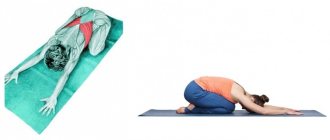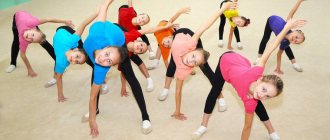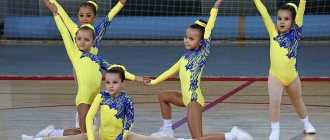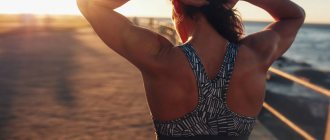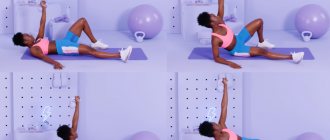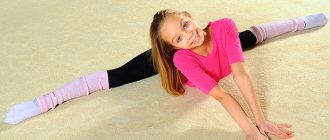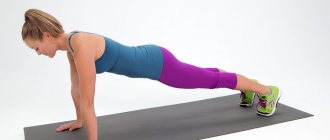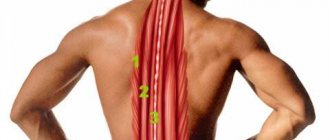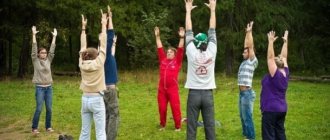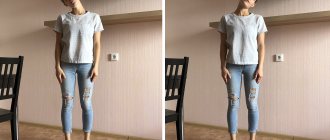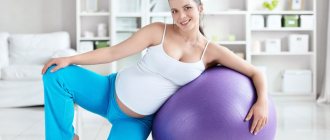Exercises for correct posture in children are a mandatory part of the health program
Pediatricians and orthopedists warn: children need to be provided with all the conditions for the correct formation of the spine.
You should take care of this from a very early age of the baby. To prevent spinal curvature and correct an existing problem, there are posture exercises for children. Along with doing it at home, you should take care of the child’s correct position at the table while eating, playing, etc.
Note! There is universal children's gymnastics for posture. This is a general therapeutic exercise developed by specialists in therapeutic and recreational physical education. It is necessary to prevent curvature of the spine and prevent diseases of the musculoskeletal system. Exercises that develop correct posture for children can be successfully done at home. They are useful for all children and serve as a simple, affordable, reliable means of prevention. During the classes, different muscle groups are used - neck, back, lower and upper extremities.
Prevention of postural disorders
With a high degree of probability, problems with the condition of the spine and back can be avoided. Prevention of postural disorders in children involves compliance with the following measures:
- Physical activity. Physical inactivity leads to a weakening of muscle tone, which is why children experience back pain and increased fatigue. It is important not only to increase your level of mobility, but also to start playing one of the sports: for example, swimming or gymnastics. To form a healthy posture, activity should not contain sudden, jerking movements or significant physical activity.
- Compliance with healthy eating rules. To prevent the children's spine from undergoing pathological changes, parents need to correctly create a menu for their children. The diet should be balanced and saturated with a sufficient amount of calcium, potassium, magnesium, vitamins (especially group B). In this case, the tissues of the musculoskeletal system receive the necessary nutrients, and the spine functions fully. If calcium is not absorbed due to thyroid dysfunction, you will need to contact an endocrinologist: undergo diagnostics and examination.
- Proper organization of the daily routine. Parents need to ensure that the child does not overwork himself physically. Proper alternation of work and rest regimes prevents overload and eliminates the need to adopt a forced body position. When periods of sitting at a desk are followed by rest breaks, the risk of developing posture problems is reduced.
- Wearing orthopedic shoes. The structure of the spine, posture, and gait depend on the anatomy of the feet. Orthopedic shoes promote the correct position of the feet and even distribution of the load on them. Therefore, the child does not develop clubfoot, shortening of the lower limbs and other disorders that affect the position of his back.
- Even distribution of the load on the body. Due to flexibility, pliability and insufficient density, the spine of preschool and school-age children is sensitive to physical impact. Regular one-sided wearing of a backpack leads to curvature of the spine, poor posture and the appearance of related health problems. The main reason is the unpreparedness of the fragile children's spine for heavy loads. When choosing a backpack, you need to take into account that it should not be wider than the child’s shoulders and below his waist.
- Proper equipment for a children's room. To prevent children from taking a forced body position during classes, they need to be provided with high-quality equipment by placing a table lamp. The table should correspond to the height of the child, the chair should follow the physiological curves of the body. Add a moderately hard mattress to the children's bed. If it is too soft, the load on the child’s back is incorrectly distributed, the spine is distorted, and stooping occurs.
For the correct development of posture, newborns can be given a light massage, the basis of which should be stroking movements. Starting from the age of 1.5 years, it is advisable to perform simple gymnastic exercises with the child aimed at maintaining the functionality of the spine and developing correct posture.
If stooping cannot be avoided, correction of the back condition begins by performing the listed actions.
Exercises to correct posture in children. When is a doctor needed?
In case of serious postural disorders, special physical therapy (PT) is indicated. Exercises for straightening posture for children are a special complex that is prescribed only by a doctor for medical reasons after an external examination of a small patient. When selecting exercises, a specialist takes into account the individual characteristics of the child’s body, the degree and nature of the curvature of the spine and many other nuances.
Causes of poor posture
Doctors identify the main factors that can lead to spinal curvature.
- Inactive lifestyle and physical activity. Muscles weaken due to prolonged sitting at a table, playing with a gadget, etc. Children of any age should move a lot, run, be in the fresh air for at least two hours a day and in any weather, play outdoor games. Ideally, a child should attend a sports section and exercise regularly under the guidance of a coach.
- Overload. Dosing physical activity and preventing injuries is a prerequisite for children’s health. Excessive exercise is no less dangerous for children than a sedentary lifestyle. If age standards regarding the duration of activities and their high intensity are not observed (for example, when preparing for sports competitions), the risks of injuries to the spine and muscles of the back, neck and shoulder girdle increase significantly. Wearing a heavy and non-ergonomic backpack also leads to poor posture.
- Bad habits. When reading or playing on a smartphone while lying down, drawing in an inappropriate position, etc., the spine gradually becomes deformed. It is necessary to teach your child to sit at the table correctly.
- Congenital pathologies of bone tissue. Doctors identify a special group of children with weakened back muscles and hereditary bone diseases. These children have a high risk of developing orthopedic diseases. For them, observation by an orthopedic doctor is mandatory. The specialist recommends a preventive or therapeutic set of exercises to strengthen posture for children at risk.
- Poor nutrition. An unbalanced daily menu becomes another factor that causes back curvature. Nutrition should include minerals, vitamins, proteins, fats and carbohydrates in the daily norms precisely indicated by doctors. In case of deficiency of useful elements necessary for the growth and development of bone and muscle tissue, the risks of scoliosis formation increase. This is especially true for preschool children.
- Poor workplace organization. Ergonomics is one of the most important points in a healthy posture program. If the workplace for games, meals and homework is poorly organized, curvature of the spine is inevitable even if all other doctor’s orders are followed. If a child walks a lot, eats right and even does posture exercises for children, but sits in the “wrong” chair, all the parents’ efforts are nullified.
| You can learn more about what doctors advise from this article. |
Exercises to strengthen the back in children
Depending on the child’s age, his emotional state and other physiological indicators, the doctor determines the duration of physical therapy sessions aimed at strengthening the spinal column.
On average, the duration of exercise is determined as follows::
- infants up to six months will benefit from exercises performed from 10 to 20 minutes a day;
- Babies from 6 to 12 months will benefit from daily thirty-minute exercises;
- Children from one to three years old can exercise up to 30-40 minutes daily.
Infants need to be introduced to physical activity gradually, because their spinal column is not yet fully formed
It is best that the first lesson is conducted by a professional massage therapist who can show parents the correct technique.
Therapeutic and strengthening exercises for the back muscles should be carried out with a certain frequency. You should start exercising 3 times a week . If the child reacts positively to the loads, their frequency can be increased to daily training.
In terms of technique, it is important to remember that any workout should begin with a warm-up. It should be followed by a basic set of exercises, necessarily including light stretching. During training, you need to avoid the same type of exercises.
You should also exclude exercises that cause pain and discomfort in the child. Physical therapy exercises, like any other sport, are most beneficial when carried out 50-60 minutes before or after a meal.
During physical exercise for therapeutic purposes, a number of simple but mandatory rules :
- A set of special exercises should be developed by the attending physician strictly according to individual indicators based on preliminary diagnosis. The recommendations given by the specialist regarding the technique of performing the exercises must be strictly followed. During physical therapy exercises, carefully monitor the child’s posture; in this case, the position of the back should be as close as possible to the physiological position.
- Physical therapy classes should be conducted in an office with special equipment. This can be either a clinic or home setting. It is important that the child always performs exercises under adult supervision.
- At the beginning of regular physical therapy classes, the child, together with one or both parents, must undergo training in the appropriate clinic room.
- Each lesson should begin with a massage and warm-up.
- The entire exercise should be performed at a slow pace, excluding sudden movements, jumps or jerks. It is not permissible to include elements of acrobatics.
- An important rule is the contraindication of increased physical activity using weights, including barbells, weights, dumbbells, if there are existing postural disorders.
- During exercise, the sensation of any, even the slightest pain should be excluded.
- Special rotational exercises or stretching of the spinal column are also not recommended for training. Only passive stretching is permissible, in which there is always support under the feet.
- The increase in loads should occur slowly and gradually, from simple to complex elements, avoiding forcing.
- When compiling a set of exercises, it should be possible to alternate the load for different muscle groups and include breathing exercises after physical training.
Video: “How to strengthen a child’s back muscles on a gymnastic ball?”
Preparation and warming up
Did you know that...
Next fact
Beginning physical therapy exercises should include the following::
- stroking;
- rubbing;
- kneading muscles;
- vibrations.
In this case, special attention must be paid to preparing the child for the procedure.
The child’s health should be good, his mood should be normal and balanced, he should feel cheerful and rested. Before starting training, the room should be well ventilated. The most optimal temperature for exercise is 18-22 degrees.
Children usually benefit from warming up their muscles with a massage or taking a warm shower before starting exercise. Classes must be held regularly at the same hours. When conducting training, it is worth playing soft music, which will help the child relax and get ready for work.
The following are suitable warm-up exercises::
- inhaling air from the stomach through the mouth, followed by holding the breath for a few seconds and then exhaling through the nose;
- rotational movements of the shoulders together and alternately;
- tilting the head in different directions;
- swing your arms;
- tilting the body in different directions from the “hands in the lock” position;
- hip rotation;
- bend down, trying to touch your hands with the tip of your toes;
- walking in place with high knees;
- running in place;
- take a deep breath and exhale completely.
Basic exercises
Basic general strengthening exercises. Below are a few more exercises to strengthen your core muscles.
The main exercises of physical therapy usually include the following::
- A ride on the bicycle . From a supine position, your legs make circular movements in the air with imaginary pedals.
- Scissors . Swing with straight legs in a horizontal direction with crossing.
- Kolobok . Pulling your legs bent at the knees, clasping them with your arms and rolling on your back along a comfortable trajectory.
- Bridge over the road . This exercise is performed from a lying position on your back, with your legs bent at the knees, your feet resting on the floor, your arms remaining along your body. You need to lift your pelvis off the floor and try to bend, lifting it as high as possible. You should stay in this position for 5 seconds, then return to the starting position.
- Acrobat . Performed from a supine position, arms lying along the body. It is necessary to raise your legs straight, trying to touch the floor behind your head with your toes.
- Kitty . Bend your back down and up from a standing position on all fours.
- Basket of berries . Lying on his stomach, the child clasps his ankles with both hands and tries to pull himself up as high as possible to a position similar to a three-dimensional basket.
- Swimmer . From a lying position on your stomach, swings are made with straight arms and legs in the air, simulating the movements of a swimmer.
- Boat . Lying on his stomach, the child should try to lift his arms and legs off the floor and freeze in the air, remaining in this position for as long as possible.
Video: “Exercises to strengthen the back muscles”
Completion
Pay attention to the final stages of gymnastics. The final exercises of physical therapy must necessarily include actions that help restore breathing and pulse, and relax all muscles.
Various shaking, rotating and stroking movements, and patting may be recommended.
It is extremely undesirable to be distracted from training in its midst by moving on to everyday activities, due to the high risk of injury to heated muscles.
At the end of the workout, it is useful to slow down the pace, which will allow the body to feel the completion of the complex.
This will leave you with a feeling of strength and vigor.
It is also useful to move on to water procedures at the end.
“Growing” stool is the best prevention of scoliosis in children of any age
From the moment the baby begins to sit up on his own, he must have the “correct” chair. For such a product, it is possible to adjust the height of the back of the chair, its seat and footrest.
All parameters of the product adapted for children correspond to:
- growth;
- age;
- anatomical features of the child;
- safety requirements for children's furniture.
Regular chairs from the mass market and adult models are not suitable for children of all age groups. Such products do not have the required adjustments, do not provide correct posture, do not train the back muscles, do not teach the child to sit correctly from an early age and cannot be adjusted as the child grows. In addition, such models are made from cheap materials that are hazardous to health.
Therefore, the optimal solution for parents would be to purchase a certified “growing” chair from a reputable manufacturer.
Types of posture disorders in children
Pay attention to the different types of spinal deformities in children from 6 to 16 years old. They all have their own characteristics and severity.
- Lordosis.
- Kyphosis.
- Scoliosis.
- Torticollis.
In the presence of any of the listed conditions, the help of a specialist and the mandatory use of a treatment and prophylactic complex are required.
Spine, its formation in children and adolescents
The spine is the central part of the human skeleton, which consists of cartilage and bone tissue, ligaments, and joints. A correctly developed column is an articulation of 33-34 segments. The anatomical structure serves as support for the body and protection of the spinal cord.
The state of posture is influenced by a person’s age. The formation of the position of the back occurs from the moment of birth. During intrauterine development, the children's spine is arched, but from the first days of a newborn's life it levels out and takes the shape of a straight line.
When the baby begins to hold his head, he gradually develops cervical lordosis. The condition involves a forward curve of the spine. As children grow older, they learn to sit independently. At this stage, kyphosis—a backward bend—occurs in the upper spine. When a child begins to walk, a characteristic forward bulge is formed in the lumbar spine - lordosis. From this moment on, it is important for parents to monitor the state of their children’s posture, since most often its violations occur in preschool age, and less often during the primary school stage.
A set of posture exercises for children. Indications for general and special physical therapy
General physical therapy is carried out in the following cases:
- leg pain and muscle weakness;
- discomfort and pain in the back, neck, sacrum, coccyx;
- rapid fatigue from physical activity.
Videos and drawings
Preventive universal exercises for preschoolers and primary schoolchildren, an example version (see figure).
How to recognize spinal curvature in time
In order to notice the deviation in time, parents need to more often pay attention to the position of the baby’s shoulders and back.
His shoulders and shoulder blades should be at the same level. The correct position of the spine is also important - whether it is curved to the right or left, whether the subgluteal folds are located at the same level. These signs of lateral curvature can be seen by examining the child from the back while he is standing. When viewed from the front, it should be noted whether the collarbones and nipples are at the same level. By looking at the side, you can identify disorders such as stooping or sluggish posture. This can be done by eye or using a special test. The child stands with his back to the wall so that the back of the head, shoulder blades, buttocks, and legs are in contact with the wall, and then takes a step forward, trying to maintain the correct body position. (This same test can be used as an exercise to develop good posture.)
If a curvature is detected, it is necessary to examine the baby's back, placing him on a flat, hard surface face down, arms along the body. If the curvature of the spinal column does not persist in the lying position, then we are only talking about a violation of posture, which can be corrected.
Muscle test . There are several simple tests to determine the state of the child’s muscular system. To do this, assess the baby’s ability to tense his back muscles for a long time. The child is placed face down on the couch so that the part of the body above the hips is suspended outside the couch, and the hands are on the belt (the child’s legs are held by an adult). Normally, children 5-6 years old can maintain a horizontal position of the body for 30-60 seconds, children 7-10 years old - 1 - 1.5 minutes, 12-16 years old - from 1.5 to 2.5 minutes. The development of the abdominal muscles is determined by the number of continuous repetitions of the transition from a lying position to a sitting position and back (while fixing the legs) at a slow pace, no more than 16 times per minute. The norm for preschoolers is 10-15 times, for children 7-11 years old - from 15 to 20 times, for children 16-18 years old - from 20-30 times.
If postural abnormalities and (or) weakness of the muscular system are detected, the child should be consulted by an orthopedic surgeon, traumatologist or physical therapist. The doctor examines the child, and if necessary, additional research methods are performed: radiography, electromyography, etc.
Recently, a new research method has emerged - topographic photometry, which allows not only to diagnose disorders of the musculoskeletal system, but also to evaluate the effectiveness of the treatment. The method is based on photographing the patient’s posture after the doctor marks the main landmarks on the child’s back with a marker.
Manual correction of stoop in children
Among the manual techniques that a massage therapist can do, we use the “upper levada.” The technique is generally more similar to passive gymnastics, but it is shown in manual therapy courses. Reception is safe, with a reasonable approach. The purpose of the technique is to physically stretch the muscular-ligamentous apparatus of the anterior surface of the chest and kyphosis of the spine, thereby freeing them from stiffness in a bent position. This will help the back muscles, after strengthening, to pull the bent shoulder girdle over themselves and align the spine to normal. The technique is carried out with the child lying on his stomach, arms extended forward, overlapping each other in the area of the forearms, head and forehead on the arms. The specialist lifts the child with one hand, placing his hand from below, just above the elbows, across, and with the other hand he fixes the area of the upper thoracic spine, then the middle thoracic and lower thoracic, i.e. With each movement, we seem to extend the arm that fixes the spine and move it a little lower. We go through this 1-2 times. There shouldn't be any pain.
Massage for stooping in children
Let's consider one of the methods used in the treatment of stoop in children, which is one of the main elements of a complex impact on the problem, this is massage. Overloaded and tense muscles are unable to maintain the child’s posture. Metabolic processes in them are disrupted and nerve conduction does not work normally. Moreover, different muscles from common groups may not experience the same loads. With massage we selectively relax the most stressed muscles and tone the weakened ones, saturate them with arterial blood rich in oxygen and nutrients, and with rhythmic kneading we form a pulse charge in the receptors at the same speed or frequency, which is sent along the sensory nerves to the brain. As a result, massage brings the muscles back to normal. Will massage help with slouching? If combined with gymnastics, it will help. By massaging the muscles, we prepare them for gymnastics and eliminate local areas of tension, this is a kind of warm-up before training.
Is it possible to correct stooped posture with massage without resorting to other methods? Separately, as an independent method, it is unlikely. Since the back becomes slouched mainly due to muscle weakness, the massage is done mainly as a tonic, this is very useful before gymnastics.
